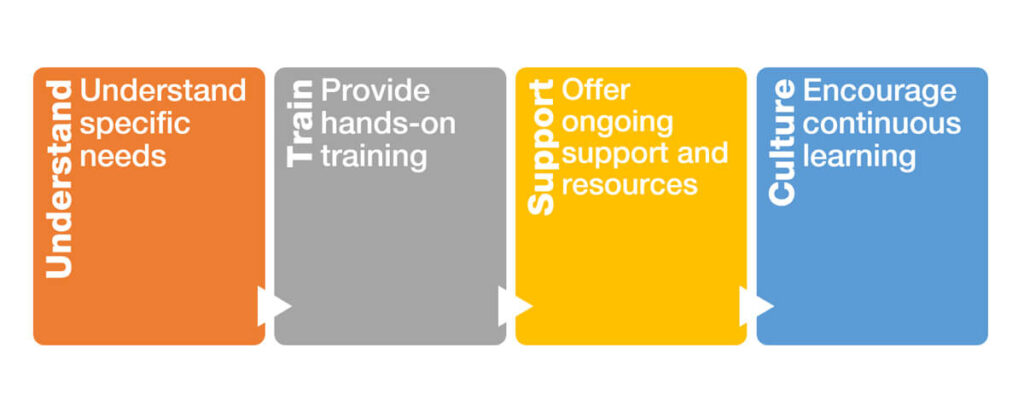Key Highlights
- HR professionals need human resources reporting software tools to manage and analyze HR data effectively.
- These tools help HR departments improve employee engagement and performance and provide actionable insights.
- BambooHR, Gusto, Zoho People, Workday, Rippling, ADP Workforce Now, Namely, Sage HRMS, Paycor, and Ceridian Dayforce are the top 10 HR reporting software tools.
- Each tool offers unique features and benefits to streamline HR processes and enhance strategic planning.
- Key features to look for in HR reporting software include custom analytics, dynamic dashboards, employee performance tracking, compliance reporting, data-driven insights, comprehensive HR solutions, customizable reporting, efficient administrative task management, streamlined HR reporting, and real-time reporting and analytics.
Table of Contents
ToggleIntroduction
With large amounts of data needed to optimize their workforce effectively, many HR professionals leverage HR reporting software tools. These tools streamline processes, analyze data, track performance, and aid in making informed decisions.
HR reporting tools offer insights into employee engagement, analytics, and performance management, all crucial for HR functions. Discover the top 10 HR reporting software tools for enhanced decision-making and strategic planning across organizations of all sizes to help transform your HR department into a data-driven resource that attracts, engages, and retains top talent with the help of new HR software.
What is Human Resources Reporting Software?
HR reporting software leverages centralized employee information to streamline HR data management and analysis by automating data collection and providing actionable insights. Key features include customizable HR reports and dashboards that track essential HR metrics for improved decision-making, performance, and engagement.
Key Features to Look for in Human Resources Reporting Software
When choosing HR reporting software, it is important to understand and consider the key features that will best meet your organization’s needs. These may be met in a single product or through a combination of products with tight integration. Here are some key features to look for.

Customizable Analytics and Reporting Dashboards
HR reporting software’s key functions include customizable analytics and reporting dashboards that enable HR professionals to track key metrics and analyze data.
These customizable analytics and reporting dashboards can be tailored to the organization’s needs, offering a comprehensive view of HR processes and performance. With these dashboards, HR teams can access and visualize data on employee engagement, performance management, and actionable insights in real-time.
This enables them to identify trends and areas for improvement and make data-driven decisions efficiently. These dashboards also serve as a valuable HR tool for monitoring and improving organizational performance.

Comprehensive Employee Performance Management
Employee performance management is an essential component of HR operations. A good HR reporting software product offers the comprehensive features needed to support it.
HR reporting software allows easy access and analysis of employee data, including:
- Goals and objectives
- Employee achievements across their goals
- Performance ratings
A good HR reporting product tracks individual and team performance, identifies top performers, and addresses performance issues. These tools help HR professionals manage and evaluate performance effectively, identify areas for improvement, and make informed talent management decisions for business growth.
They also assist in setting and tracking performance goals, conducting reviews, and providing employee feedback, ensuring individual performance matches organizational objectives.

Robust Compliance and Security Measures
HR reporting software tools must offer robust security features to safeguard sensitive HR data, a level of data protection compliance vital to HR professionals. They ensure data is stored securely and accessed in compliance with laws like GDPR, providing encryption and authentication to protect against unauthorized access.
These tools also enable the definition of access permissions and prevent data breaches and unauthorized changes to HR records.

Exploring the Top 10 Human Resources Reporting Software Tools
There is a wide variety of HR reporting software tools for human resources professionals. These tools streamline HR processes, enhance data analytics, and aid strategic planning, including talent acquisition.
Use this reference to dive into each tool’s details to uncover its unique features and benefits, including:
- Applicant tracking system
- Onboarding module
- Performance management tools
- Succession planning features
Then, compare it to an all-in-one human resources management platform that streamlines the hiring process for new employees.

1. BambooHR: Streamlining HR Processes with Custom Analytics
BambooHR is known for its user-friendly interface and customizable features, making it ideal for small and medium-sized businesses. Its custom analytics enable HR professionals to gain valuable insights into HR processes, employee performance, and workforce planning.
Its key features include:
- Customizable analytics dashboard to enable tracking of key HR metrics in real time.
- Custom reports and other advanced reporting capabilities allow HR professionals to structure and visualize data according to their needs.
- Performance management features that help HR professionals track employee performance and set goals.
- Time-off tracking and management features that simplify leave management.
- Employee self-service portal that empowers employees to access HR services and update their information, enabling HR departments to scale support.

2. Gusto: Enhancing Decision-Making with Dynamic Dashboards
Gusto is a comprehensive HR and payroll software solution that offers dynamic dashboards to enhance decision-making. It provides HR professionals with a visual representation of key HR and payroll data, enabling them to make informed decisions and drive strategic planning.
With Gusto, HR professionals can streamline HR and payroll processes and improve efficiency.
Its key features include:
- Dynamic dashboards providing real-time insights into key HR and payroll metrics.
- AutomatedPayroll managementprocesses that help ensure compliance with tax regulations.
- Benefits administration features that make it easier to manage employee benefits.
- Time tracking and management features that streamline attendance tracking and time-off requests.
- Employee onboarding and self-service features that empower candidates and employees to manage tasks and information.

3. Zoho People: Employee Performance Tracking for Strategic Planning
Zoho People is an HR software solution that offers employee performance-tracking features. These features give HR professionals valuable insights into employee performance, enabling them to make data-driven decisions and drive strategic planning.
Its key features include:
- Performance appraisal features allow HR professionals to collaborate with managers to improve employee performance tracking and evaluation with strong goal management capabilities.
- Competency mapping functionality helps HR professionals identify skill gaps and allocate resources accordingly.
- Succession planning facilitates long-term strategic planning and talent management.
- Employee engagement features that enable HR professionals to measure and improve employee satisfaction.

4. Workday: Advanced Compliance Reporting Features
Workday is a cloud-based HR software solution that offers advanced compliance reporting features.
These capabilities enable HR professionals to ensure compliance with regulatory requirements and mitigate compliance risks effectively, but aside from reporting, Workday is a full-service human capital management platform.
Its key reporting features include:
- Compliance reporting functionality to help HR professionals ensure adherence to regulatory requirements.
- Data analytics capabilities that enable HR professionals to analyze HR data and identify compliance risks.
- Employee data management features that facilitate the collection and organization of employee data.
- Integration capabilities that allow HR professionals to connect Workday with other HR and workflow management systems for streamlined operations.
- Self-service features that empower employees to access HR services and maintain their information.

5. Rippling: Optimizing HR Operations with Data-Driven Insights
Rippling is an HR and IT management software solution that offers data-driven insights to optimize HR operations.
Rippling’s data-driven insights and integration with IT enable HR professionals to optimize HR operations, make informed strategic planning decisions, and manage their workforce.
Its key features include:
- Data analytics tools provide HR professionals with valuable operational insights.
- Employee data management features that streamline HR processes and ensure data accuracy.
- Onboarding and offboarding workflows that automate employee onboarding and offboarding processes.
- Time and attendance tracking that simplifies time tracking and attendance management.
- Benefits administration module that helps HR professionals manage employee benefits effectively.

6. ADP Workforce Now: Comprehensive HR Solutions for Businesses
ADP Workforce Now is a comprehensive HR software solution offering a comprehensive set of HR solutions.
ADP Workforce Now provides various HR solutions catering to the diverse needs of businesses and their HR teams. It enables HR professionals to streamline HR processes, improve workforce planning, and enhance efficiency.
Its key features include:
- Payroll management workflows that automate payroll processing and ensure compliance.
- Time and attendance features that streamline time tracking and attendance management.
- Benefits administration module that simplifies the management of employee benefits.
- Talent management features enable HR professionals to manage employee performance and career development.
- Workforce planning capabilities that help HR professionals forecast and plan for future workforce needs.

7. Namely: Customizable HR Reporting for Modern Companies
Namely offers customizable HR reporting features, making it an ideal choice for modern companies requiring flexible and tailored reporting solutions. With Namely, HR professionals can track HR metrics, analyze data, and make informed decisions for strategic planning.
Its key features include:
- Customizable reporting allows HR professionals to create reports tailored to their organization’s needs.
- Employee data management simplifies employee data collection, organization, and analysis.
- Performance management module that enables HR professionals to track employee performance and set goals.
- Benefits administration functionalities that streamline the management of employee benefits.
- Time and attendance tracking features that simplify time tracking and attendance management.

8. Sage HRMS: Efficient Administrative Task Management
Sage HRMS is an HR management software solution that offers efficient administrative task management features. Sage HRMS’s task management and workflow features enable HR professionals to streamline HR processes, improve efficiency, and focus on strategic HR management.
Its key features include:
- Employee data management to streamline administrative tasks like employee record management and data entry.
- Payroll features that automate payroll processes and ensure compliance with tax regulations.
- Time and attendance tracking capabilities to simplify time tracking and attendance management.
- Benefits administration features to help HR professionals manage employee benefits effectively.
- Reporting and analytics capabilities, providing HR professionals with valuable insights into HR operations.

9. Paycor: Streamlined HR Reporting for Strategic HR Management
Paycor offers streamlined HR reporting features for strategic HR management.
Their streamlined HR reporting features enable HR professionals to analyze HR data, make informed decisions, and drive strategic improvements to HR management.
Its key features include:
- HR reporting capabilities that provide HR professionals with valuable insights into HR metrics and trends.
- Employee data management that streamlines HR processes and ensures data accuracy.
- Payroll process automation and management to ensure compliance.
- Time and attendance tracking functionalities that simplify time tracking and attendance management.
- Benefits administration module that helps HR professionals manage employee benefits effectively.

10. Ceridian Dayforce: Real-Time HR Reporting and Analytics
Ceridian Dayforce is an HR software solution that offers real-time HR reporting and analytics capabilities that provide HR professionals with valuable insights into HR operations, enabling them to make data-driven decisions and drive employee engagement.
Its key features include:
- Real-time reporting functionalities that provide HR professionals with up-to-date insights into HR metrics and trends.
- HR analytics capabilities that enable HR professionals to analyze HR data and identify patterns and trends.
- Employee engagement features that help HR professionals measure and improve employee satisfaction.
- Payroll management functionalities that streamline payroll processes and ensure compliance.
- Time and attendance tracking features that simplify time tracking and attendance management.

HR Reporting Software Comparison Matrix
Based on the features described previously, here is an at-a-glance matrix of HR reporting software products and HR management platforms:
Benefits of Implementing HR Reporting Software
Implementing HR software yields some key benefits to many organizations. Here are some of them.
Time Savings on HR Administrative Tasks
Automating processes like report generation, employee information management, and payroll processing saves HR personnel time on administrative tasks, allowing HR professionals to focus on strategic initiatives with improved data accuracy.
Automated onboarding tools and dashboards can help employers automatically set up employee accounts with all necessary information, such as tax forms, benefits packages, company policies, and health insurance. This saves even more time and energy while ensuring accuracy and improving the new employees’ experience.
Employees can also use the self-service feature to request time off, clock in and out of shifts, update professional goals, and track training assignments. This helps HR personnel scale support activities and allows them to focus on more common tasks, such as generating new hire reports that help with hiring strategies.
Enhanced Strategic Decision-Making Capabilities
Implementing HR reporting software enhances HR professionals’ strategic decision-making capabilities by providing advanced analytics and actionable insights.
These tools offer valuable data on workforce trends, performance metrics, employee engagement levels, and employee sentiment. They use predictive analytics and machine learning algorithms to provide informed decisions that improve HR practices and align with organizational goals.
For example, analyzing employee turnover rates and sentiment can help develop effective retention strategies and enhance the overall employee experience and company culture, which is a good thing for any organization.

Selecting the Right HR Reporting Tool for Your Business
Selecting the right HR reporting tool is essential for organizations to manage HR data and drive better business outcomes effectively. Here are some factors to consider when choosing an HR reporting tool.
Evaluating Your HR Reporting Needs
The most important activity when choosing an HR reporting tool is evaluating the organization’s specific needs:
- Identify key HR metrics and reports required
- Consider data integration sources
- Assess user interface preferences.
To get the most out of the tool, it is also beneficial to plan integration with HRIS systems, performance management software, and payroll software. Prioritize user-friendly interfaces and customizable dashboards for your HR team.
Assessing Software Scalability and Support
When choosing an HR reporting tool, prioritize scalability and vendor support. Ensure the tool can grow with the organization’s data needs and integrate new sources. Also, assess the vendor’s technical support, software updates, and training resources for a successful implementation.

Integrating Human Resources Reporting Software into Your HR Strategy
Integrating HR reporting software into the HR strategy can significantly enhance HR operations and contribute to the organization’s success. Here are some best practices for implementation.

Best Practices for Implementation
When integrating HR reporting software into the HR strategy, it is essential to follow best practices for implementation to ensure a successful outcome. Here are some key best practices for implementation:
- Gather and involve key stakeholders: Throughout the implementation process, engage key stakeholders, such as HR team members, IT personnel, and senior management. Their input and support will be crucial for successfully adopting and utilizing the software.
- Conduct a thorough needs assessment: Before implementing HR reporting software, assess your organization’s specific HR reporting needs, goals, and challenges. This will help you identify the features and functionalities required from the software.
- Create a clear implementation plan: Develop a detailed plan outlining the steps, timeline, and responsibilities for implementing the HR reporting software. This will help ensure a smooth and organized implementation process.
- Provide comprehensive training: Provide thorough training on how to use the HR reporting software effectively. This will enable the HR team to navigate the software’s features, generate reports, and interpret the data and insights provided.
- Monitor and evaluate: Continuously monitor and evaluate the effectiveness of the HR reporting software implementation. Gather user feedback, track key metrics, and make adjustments to optimize results.

Training Your Team on New Tools
Training ensures any HR team can use the new tools effectively. Performing the following planning activities can help ensure this:
- Training needs assessment: Before designing the training program, assess the HR team’s skill levels and knowledge gaps. This will help tailor the training to their specific needs.
- Provide hands-on training: Offer practical training sessions where HR team members can interact with the software and explore its features. This will help them become familiar with the interface and functionalities.
- Offer ongoing support and resources: Ensure HR team members can access comprehensive support materials, such as user guides and video tutorials, to refer to when needed. Also, provide a dedicated support channel where team members can ask questions and seek assistance.
- Encourage continuous learning: Foster a culture of continuous learning within your HR team. Encourage them to explore advanced features of the HR reporting software, attend webinars or workshops, and share best practices with colleagues.
Conclusion
In conclusion, selecting the right Human Resources Reporting Software can significantly impact your business operations. These tools offer comprehensive solutions tailored to modern HR needs, from streamlined HR processes to enhanced decision-making capabilities. By evaluating the organization’s reporting requirements and considering factors like scalability and support, you can implement a system that saves time on administrative tasks and empowers strategic planning. Investing in the right HR reporting tool is a strategic decision that can drive efficiency and productivity within your organization.





